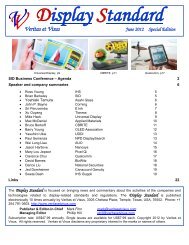Create successful ePaper yourself
Turn your PDF publications into a flip-book with our unique Google optimized e-Paper software.
<strong>Veritas</strong> <strong>et</strong> <strong>Visus</strong> <strong>Display</strong> <strong>Standard</strong> February 2009<br />
Toshiba products ranked as most eco-conscious<br />
A disassembled Toshiba Portégé R600 ultra portable laptop PC, ranked as one of the most eco-conscious laptop<br />
computers sold in the US by the federal Electronic Product Environmental Assessment Tool (EPEAT). The “E-<br />
Core LED Downlight” is an energy-efficient LED lamp that uses one-seventh the power of a traditional<br />
incandescent bulb of equal brightness. All fall 2008 and 2009 Toshiba TVs not only qualify but also exceed the<br />
EPA’s Energy Star Version 3.0 specification by at least 15%.<br />
Sony Green Glove delivery service recycles old TVs<br />
Sony unveiled a new premium delivery service it calls “Green Glove”. When Sony Style customers buy 32-inch or<br />
larger BRAVIA LCD TVs at a Sony Style store or at Sonystyle.com and opt for premier in-home delivery service,<br />
the delivery company will remove the old TV s<strong>et</strong> for recycling and remove the Sony packaging for recycling. Sony<br />
recycles the old TVs via Waste Management Recycle America. The company also runs a Take Back Recycling<br />
program that provides free recycling for all Sony-branded products managed by the same recycling firm. Recycling<br />
efforts from the Take Back program have collected more than 11.9 million pounds of electronics waste so far, and<br />
the amount of recycled electronics is expected to grow rapidly. http://www.sonystyle.com<br />
Energy Star may make new TV specifications more stringent<br />
A stricter Energy Star spec may be implemented later this year. The Energy Star 3.0 specification s<strong>et</strong>s standards for<br />
total power consumption when a TV is on, as well as the power it uses when in “standby,” or off. A 42-inch flatpanel<br />
TV must use 208 watts or less, and a 50-inch 318 watts or less to<br />
display the Energy Star logo; they must also use less than 1 watt while in<br />
standby. When turned off, many electronics still use a small amount of<br />
power for remote control sensing and other functions. About 460 TVs<br />
have qualified for Energy Star since the new spec went into effect in<br />
November. Too many TVs appear to have qualified to display the Energy<br />
Star logo. Energy Star is supposed to signify that a product is more<br />
efficient than most others in its category. So when the EPA s<strong>et</strong>s an Energy<br />
Star standard, it anticipates that about 25% of the models in that class will<br />
qualify. When considerably more than that me<strong>et</strong>s the voluntary standards,<br />
new and more stringent requirements can be implemented, with the goal<br />
of improving energy efficiency further. http://www.energystar.gov<br />
Worldwide contest challenges participants to “Save the Earth”<br />
The IEEE Committee on Earth Observation (ICEO) is launching “SaveEarthGame”, two international computer<br />
game design contests, with a top prize of $20,000, that challenge participants to demonstrate how real-world events<br />
affect the Earth and impact people. A panel of specialists will award prizes for the two different contests. The first<br />
contest is open to all age groups, and is for the development of a game concept. It does not require any computer<br />
programming skills, just imagination and ingenuity. Contestants will create a computer game concept using Earth<br />
observations to contend with a myriad of environmental issues that impact Earth: disasters, health, energy, climate,<br />
water, weather, ecosystems, agriculture and biodiversity. Entries should be submitted by April 10, 2009. The<br />
winners will receive a Computer Game Development Workshop Class and cash prizes ranging from $100 to $1000.<br />
The second contest, which kicks off May 1, 2009, is to design a playable, prototype computer game and requires<br />
game development skills. Contest participants are encouraged to use earth observation data as a means to forecast<br />
and respond to environmental challenges. Contestants will be able to communicate globally with IEEE engineers,<br />
GEO teams and scientists as mentors and as an additional resource in game development. Proposals must be<br />
submitted by June 30, 2009. At that time, judges will identify finalists who will have until August 2010 to create<br />
and submit functional, playable games. The winner receives a $20,000 prize plus an expense-paid trip to the Group<br />
on Earth Observations (GEO) Summit. http://www.SaveEarthGame.org<br />
83






